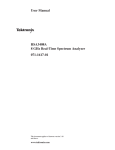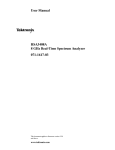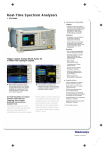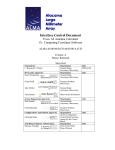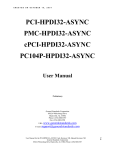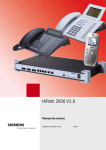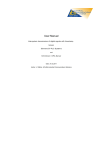Download File
Transcript
White Paper
Digital I-Q Data Capture and Correction
Abstract: The RSA3408A Opt. 05 provides real-time digital I and Q outputs on the RSA3408A. Data of
bandwidths up to 36 MHz span may be collected continuously at these ports. This white paper explains the theory
of operation of the internal acquisition memory and data correction methods of the RSA3408A, and offers a method
by which these corrections may be applied to data captured using an external PC.
1.0
RSA3408A Internal Acquisition, Storage, and Data Correction (Overview)
A brief description of the internal signal acquisition and correction process is provided as an introduction to the
operations required when performing these functions on an external PC. Detailed descriptions of the internal
operation of the RSA3408A can be found in the RSA3408A User Manual, P/N 071161701.
1.1
Internal Signal Acquisition:
The RSA3408A digitizes the incoming signal at an intermediate frequency of 76 MHz. This data path is 36 MHz
wide, digitized at 102.4 MSamples/sec with 14 bits resolution. This data is then digitally downconverted to I and Q
samples at 51.2 MSamples/sec for both the I and Q signals. This information is then decimated to produce the
desired span of analysis, ranging from 36 MHz span to as narrow as 100 Hz. This uncorrected data is then stored
in the acquisition memory of the RSA3408A.
1.2
Internal Post Acquisition Data Correction:
The data stored in the RSA3408A acquisition memory must be corrected for errors caused by the frequency
response/group delay of the RF. Correction is performed by application of the Flatness Correction Data followed by
the Calibration Data. These files are unique to each RSA3408A and are created during factory calibration. These
corrections are performed automatically each time the data is used to produce measurement results in the RSA
and the process is not seen by the user of the instrument. This is true even if the data has been stored to the hard
drive.
2.0
RSA3408A Option 05 External Storage and Data Correction (Overview)
When external storage is used in conjunction with the Option 05 Digital IQ outputs, the correction process normally
performed by the RSA software must be performed externally. A diagram of the hardware required and the data
flow for external capture and correction is shown in Figure 1 below.
Figure 1: Hardware Wiring and Data Flow, RSA3408A Option 05
Figure 1 shows that the Flatness Correction Data and Calibration Parameter files are collected from the RSA3408A
via GPIB commands sent from the data collection PC. Uncorrected (Raw) I and Q samples are collected into the
PC memory via an interface cable and data collection card. Applying the calibration and correction files to the raw
IQ samples results in a corrected IQ file ready for further processing. Each step of this process will now be
considered in detail.
2.1 IQ Data Structure and Correction Factors in Detail
2.1.1 Raw IQ Data
Raw (uncorrected) IQ data points, are sent from the connector on the rear panel of the RSA3408A. 16 bit LVDS
signals are used for both I and Q. Although the A/D converters are 14 bits in resolution, up to 16 bits of data may
be available on I and Q as a result of span-dependent decimation. Since these signals are the same as data
tapped at the output from the DDC of the RSA3408A, this is time-domain data. The data rate of the I and Q outputs
is defined by the span setting of the RSA3408A. Data is sent from the option 05 outputs as shown in Figure 2.
Type : signed integer 16bit
one I data sample
one Q data sample
Figure 2: Option 05 Output Data Format
Figure 3 shows the relationship of span setting, data rate and data size of the captured signals. There is no limit to
the data size that may be sent by these outputs, but memory sizes will limit the practical length of the collection
time.
Figure 3 : Relation of span, data rate and data size
For compensation of the raw IQ daa stream using the SW algorithm in this documentation, a data file that has
the following data structure is required. The user should prepare their HW to capture raw IQ data into PC
memory in accordance to the following structured data file (Figure 4). A method for transferring raw IQ data into
a PC memory is described in Section 3. The raw IQ file should be stored on the controller PC as “RAW_IQ.DAT
File contents: IQ data to be converted in [ Voltage ] and to be corrected.
2
Figure 4: data structure of whole Raw iq data
2.1.2 Flatness Correction Data (Gain and Phase)
This data is used for compensating flatness errors in the uncorrected IQ data file and consists of gain and phase
components. The GPIB command used to retrieve the gain components of the flatness correction data is:
“:CALibration:IQ:CORRection:MAGNitude? ”
The Data format of the response from the RSA3408A is shown in Figure 5.
Figure 5 : data format of Gain components
Similarly, the command for retrieving phase correction data is:
“ :CALibration:IQ:CORRection:PHASe? “
The Data format of the response from the RSA3408A is shown in Figure 6.
3
Figure 6: data format of Phase components
The Gain and Phase components correspond to a frequency bin and both are expressed in the frequency domain.
The formulas for producing Flatness Correction data from the files retrieved from the RSA3408A as I and Q in
floating point is shown below.
1) a pair of Gain and Phase corresponds to a frequency bin
2) data under frequency domain
3) formula to see Flatness Correction Data, just retrieved from RSA3408A, as IQ factor counted by floating point
Amplitude n
=
Phase n [radian]
√ 10 (An/32768 x 10)
An : A1, A2,…..A1024 (As in Fig: 5)
= Pn / 32768.0 * PI / 180
Pn : P1, P2,…..P1024 (As in Fig. 6)
Therefore, the formula to provide IQ values of the Flatness Correction table from Amplitude and Phase is as
below.
Flatness Correction data In = 1.0 / Amplitude n * cos( Phase n )
Flatness Correction data Qn = 1.0 / Amplitude n * sin( Phase n )
2.1.3 Calibration Parameter file
A calibration parameter file is generated in the RSA3408A during setup of the instrument for data acquisition. The
calibration parameter file corrections must be performed on externally stored raw IQ files. These parameters are:
i)
ii)
iii)
iv)
v)
GainOffset [dB] : gain offset for amplitude value
MaxInputLevel [dBm] : reference level set by RSA3408A when acquiring data
LevelOffset [dB]: level offset set by RSA3408A when acquiring data
IOffset : Offset value of I data
QOffset : Offset value of Q data
All of the parameters listed above can be retrieved via GPIB command as shown below (Figure 7).
4
GPIB Command: “ :CALibration:IQ:HEADer? “
Data format of response from RSA3408A (note: data is in ASCII code):
"Type=RSA3408AIQT
FrameReverse=Off
FramePadding=Before
Band=RF1
MemoryMode=Zoom
FFTPoints=1024
Bins=721
MaxInputLevel=0
LevelOffset=0
CenterFrequency=1.5G
FrequencyOffset=0
Span=36M
BlockSize=2
ValidFrames=3730
FramePeriod=20u
UnitPeriod=20u
FrameLength=20u
DateTime=2005/01/24@14:56:42
GainOffset=-82.2601145991602
MultiFrames=1
MultiAddr=0
IOffset=0.0361328125
QOffset=-0.01800537109375
“
Figure 7: Response of GPIB command :CALibration:IQ:HEADer?
2.2 Calibration and Corrections: Time and Frequency Domains
As is seen in Figure 8 (Below), the calibration factors (amplitude scaling) are applied to the raw time domain I and
Q samples. The frequency-domain flatness correction data is applied following an FFT of the amplitude scaled I
and Q samples. After the Flatness Correction data is applied, an IFFT is performed, resulting in scaled, corrected I
and Q data.
Details on the frequency domain processing of the flatness correction data are found in Appendix C and D
5
cal_para.txt
a_raw_flt.dat
p_raw_flt.dat
Convert scale to voltage
Convert data from AP to IQ
FFT
Extend data length to 2048
F-domain raw IQ data
Apply correction data
F-domain corrected IQ data
F-domain correction data
IFFT
Convert data format to ASCII
Time domain data
Frequency domain data
corrected_iq.txt
Figure 8: Corrections Applied in Time and Frequency Domains
3.0 An Application Example
This section will demonstrate the collection of raw IQ files into an external PC, and provides software (See
Appendix A) implementing the described IQ correction process. Using these techniques, corrected data from the
RSA3408A can be used by external data analysis software with confidence in the accuracy of the result.
3.1 Setup Description
The setup required for capture of raw IQ from the RSA3408A is shown in Figure 9 below.
Figure 9: Hardware and SW Diagram for Raw IQ Capture
3.1.1 Preparation – 32bit Parallel Digital I/O Card
Tektronix recommends the hardware and software described below for data capture from the RSA3408A Option
05.
Digital I/O card : PCI64-HPDI32A
Cable : twisted pair cable (see 3.1.3)
sw
: HPDI32 driver/API Release 4.0.0.7, 2004-12-29
vendor: General Standards Corporation (http://www.generalstandards.com)
6
Note: When RSA3408A option 5 operates at 36MHz span, the rate of IQ data out become 204.8 Mbytes/sec.
(16 bits X 2 X 51.2 Mbits/sec) Tektronix recommends to use 64 bits PCI interface.
3.1.2 Installation – 32 bit Parallel Digital I/O Card
The process to setup is the following.
1) prepare an external PC running Windows.
2) Install PCI64-HPDI32A DIO card into external PC
3) install HPDI32 driver in external PC.
4) connect Option 5 on rear panel of RSA3408A to external PC via 32bit HPDI32A I/F using the twisted
pair cable (see 3.1.3)
3.1.3 Connecter on the rear of RSA3408A
RSA3408A has two connecters for Digital IQ output on the rear panel, one is for “I” out and the other one is for “Q”
out. The connecter specification is as following.
Pin assignment (Rear view)
25
24
2
50
49
27
1
1
26
Connector P/N 10250-1210VE
Vender of connecter: 3M corp.
The connection details between RSA3408A rear connecters and I/F
card are shown in Figure 2
Note:
Regarding the Both connecters for raw I and Q data
Pin1 and Pin26 should be connected to ground at the RSA3408A side
Pin25 and Pin50 are clock output from RSA3408A.
3.1.4 Twisted Pair Interface
The cable connecting the RSA3408A to the digital I/O card can be either made by the user or purchased.
If you wish to produce the cable in-house, connection details are shown in Figure 10.
7
Figure 10: Pin Assignments for Twisted Pair Cable
8
3.2 Collect raw IQ data from RSA3408A, and Data correction
The steps for retrieving raw IQ data from Option 5 of RSA3408A are the following.
1) Setup environment described in 3.1
2) Enable Option 5 on RSA3408A, see user manual.
3) On external PC, invoke sample program explained in 4.1 to capture data from RSA3408A.
4) On external PC used in step 3 or other, prepare of flatness correction file and calibration parameter file
described in 4.2.1.
5) On either external PC used in above step 3 or other, invoke sample flatness correction program
explained in 4.2 together with input file, RAW_IQ.dat, just created in previous step 3). See 4.2.
6) corrected_iq.txt, described in 4.2.2, will be created. See 4.2 and Appendix D
4.0 Sample programs
This application note has sample source programs to install the following four commands.
- captureiq:
This command is used for data gathering from HPDI32A interface board and creates a raw IQ data file
(raw_iq.dat) for data recording.
- makecaldata:
This command creates three calibration files from an IQT file. The calibration files are as follows.
1) Amplitude flatness correction data file (a_raw_flat.dat)
2) Phase flatness correction data file (p_raw_flat.dat)
3) Calibration parameter file (cal_para.txt)
The contents of these files can be received by using GPIB commands also (See 3.1).
- makeiqt:
This command creates an IQT format file (captured.iqt) from the raw IQ data file and the calibration files.
- correctiq:
This command corrects IQ data in the raw IQ data file by using the calibration files and writes the corrected IQ
data into an ASCII IQ data file (corrected_iq.txt).
The relation between these commands and files is shown in Figure11.
captureiq
HPDI32A I/F
RSA3408A
GPIB
raw_iq.dat
correctiq
XXX.iqt
XXX.iqt
a_raw_flt.dat
corrected_iq.txt
Copy
p_raw_flt.dat
makecaldata
cal_para.txt
IQ data
makeiqt
Calibration files
captured.iqt
Calibration data
External PC
Figure 11 Relation between commands and files
Microsoft Visual C++ v6.0 is used to build execution modules of these commands from sample programs. All
execution modules are executed as DOS commands.
9
4.1 Functional Description, Captureiq
4.1.1 Installation
The following files are needed to install captureiq command. Put these files into your working folder (Header files
and library file are provided by General Standard Corporation).
- Source file : captureiq.c (Appendix-A)
- Header files
: gsc_common.h, gsc_pci9080.h, gsc_pci9656.h, hpdi32_api.h
- Library file
: hpdi32_api.lib
-
The execution module (captureiq.exe) is created by the following command.
> cl captureiq.c hpdi32_api.lib
4.1.2 Synopsys
- captureiq [sampling-points]
One sampling data point is 4 bytes and one data sample data interval is depends on the RSA3408A
SPAN setting.
4.1.3 Input, output
- Input
: Raw IQ data from HPDI32A interface board.
- Output file : raw_iq.dat (see 3.1.1)
4.1.4 Description
Captureiq command captures IQ data from HPDI32A interface board and saves the data into a raw IQ data file.
The raw IQ data file name is raw_iq.dat. The command argument ‘sampling-points’ is an integer value and
captureiq captures and saves specified points of IQ data. If no argument is given, captureiq captures 10G points
data.
(This command requires 1GB memory on PC as software FIFO buffer.)
4.2 Functional Description, Makecaldata
4.2.1 Installation
The following files are needed to install makecaldata command. Put these files into your working folder.
- Source file : makecaldata.c (Appendix-B)
- Header file : rtsa_iqt.h (Appendix-E)
-
The execution module (makecaldata.exe) is created by the following command.
> cl makecaldata.c
4.2.2 Synopsys
- makecaldata IQT-file
4.2.3 Input, output
- Input file
: IQT format file
- Output files : a_raw_flt.dat, p_raw_flt.dat, cal_para.txt (see 3.1.2 and 3.1.3)
4.2.4 Description
Makecaldata command reads data for calibration from an IQT file and creates three calibration files. The IQT file
name should be specified by the command argument ‘IQT-file’.
4.3 Functional Description, Makeiqt
4.3.1 Installation
The following files are needed to install makeiqt command. Put these files into your working folder.
- Source file : makeiqt.c (Appendix-C)
- Header file : rtsa_iqt.h (Appendix-E)
-
The execution module (makeiqt.exe) is created by the following command.
> cl makeiqt.c
10
4.3.2 Synopsys
- makeiqt
4.3.3 Input, output
- Input files : raw_iq.dat, a_raw_flt.dat, p_raw_flt.dat, cal_para.txt
- Output file : captured.iqt
4.3.4 Description
Makeiqt command reads IQ data, file header information and flatness correction data from the raw IQ data file
and the calibration files, then creates IQT format file according to the data. The IQT format file name is
captured.iqt.
4.4 Functional Description, Correctiq
4.4.1 Installation
The following file is needed to install correctiq command. Put this file into your working folder.
- Source file : correctiq.c (Appendix-D)
The execution module (correctiq.exe) is created by the following command.
- > cl correctiq.c
4.4.2 Synopsys
- correctiq
4.4.3 Input, output
- Input files : raw_iq.dat, a_raw_flt.dat, p_raw_flt.dat, cal_para.txt
- Output file : corrected_iq.txt
4.4.4 Description
Correctediq command reads IQ data and calibration data from the raw IQ data file and the calibration files,
corrects IQ data according to the calibration data, converts the data format from binary to ASCII, then writes the
data into an ASCII IQ data file. The method of data correction is described in 4.6. The ASCII IQ data file name is
corrected_iq.txt.
4.5 Data files
4.5.1 Raw IQ data file (raw_iq.dat)
Raw IQ data file has a sequence of IQ data captured from HSDP32A interface, which is described in 3.1.1. One
point data in this file is composed by two short integers which correspond to I and Q value, so the size of a point
data is 4 bytes. If the number of points captured by cuptureiq command is N, the size of raw IQ data file is 4N
bytes. A point data is read from HSDP32A interface as an integer (4 bytes) which has both I and Q data, and the
byte order of the Windows PC is little endian. So the byte order of IQ values in this file is shown in Figure12.
Head of the file
Q low byte
End of the file
Q high byte
I low byte
I high byte
One point data
Figure 12: Byte order of IQ in raw IQ data file
4.5.2 Amplitude flatness correction data file (a_raw_flt.dat)
Amplitude flatness correction data file has 1024 integers (4096 bytes) which are described in 3.1.2 (A1, A2, …,
A1024). This file is created by makecaldata command, otherwise the contents of this file can be gotten from the
response of GPIB command. The byte order of an integer is little endian in this file (Low byte first).
4.5.2 Phase flatness correction data file (p_raw_flt.dat)
Phase flatness correction data file has 1024 integers (4096 bytes) which are described in 3.1.2 (P1, P2, …,
P1024). This file is created by makecaldata command, otherwise the contents of this file can be gotten from the
response of GPIB command. The byte order of an integer is little endian in this file (Low byte first).
11
4.5.3 Calibration parameter file (cal_para.txt)
Calibration parameter file has measurement parameters as text data, which are described in 3.1.3. This file is
created by makecaldata command, otherwise the contents of this file can be gotten from the response of GPIB
command.
Correctiq command converts raw IQ data to IQ values in voltage using some calibration parameters (GainOffset,
MaxInputLevel, LevelOffset, IOffset, QOffset). The following formulas are applied for the conversion (Iraw and
Qraw are IQ values in raw IQ data file).
IQScale = sqrt(Power(10,(GainOffset + MaxInputLevel + LevelOffset)/10/20*2))
I [V] = (Iraw – IOffset ) * IQScale
Q [V]= ( Qraw – QOffset ) * IQScale
4.5.4 Corrected ASCII IQ data file (corrected_iq.txt)
Corrected ASCII IQ data file has a sequence of IQ data in ASCII format. In this file, one line has two real values
which correspond to I and Q. The two values are separated by comma (,) as shown below.
-1.520849e-002,2.921454e-003
-1.520110e-002,7.701263e-004
1.432840e-002,-1.596774e-003
.
.
.
4.6 Details of frequency-domain flatness correction process
1) It needs to extend flatness correction data with 1024bins to 2048bins. Following is the process of extension.
Figure 13: Extension of flatness correction data
2) Compensating IQ data with N points length : framing
(Making one data block, named “frame” as one data block in this case)
Assume IQ data to be corrected has N points length of itself, making each data frame whole IQ data
into n frames under the below condition.
12
N = 1024 * ( n -1 ) + m ( n, m : integer, 0 < m <= 1024 )
Figure 14: Before filling up to 1024 points with “0” at last frame as a dummy data
3) Compensating IQ data with N points length : padding with “0” data as a dummy
Figure 15: After filling up to 1024 points with “0” at last frame as a dummy data
4) Compensating IQ data with N points length: apply flatness correction data
compensating each frame, called Frame i, where i will be 0 through n-1
Figure 16: Application of flatness correction data
13
Appendix A: captureiq.c
/* Copyright (C) Tektronix */
#include <windows.h>
#include <stdio.h>
#include <fcntl.h>
#define MIN_FIFO_BYTES
64000000
#define REPORT_POINTS
256000000
#define OPEN_MODE (O_WRONLY | O_TRUNC | O_CREAT | O_BINARY | O_SEQUENTIAL)
#define READ_WAIT 1
#define READ_SUSPEND
#define READ_STOP 3
2
#define USAGE\
fprintf(stderr,\
"captureiq [-f FIFO-size(bytes)] [-s sample-points] [-t sample-time(sec)] [output-file]\n")
#define GET_FIFO_DISTANCE()\
(fifoBufSize * (readCycle - writeCycle) + readPosition - writePosition)
char
*outputFile = "raw_iq.dat";
int
fifoBytes = 1000000000;
double samplePoints = 10e9;
double sampleSeconds = 0.0;
int
*fifoBuffer;
int
int
int
readBufSize = 48000;
writeBufSize = 0;
fifoBufSize;
int
int
int
int
int
readCycle;
readPosition;
writeCycle;
writePosition;
maxDistance;
int
readStatus;
HANDLE
readThread;
int
errorCount;
double spentTime;
double readTime;
int
int
int
hpdi32InitializeDevice(void);
hpdi32ReadReset(void);
hpdi32ReadData(int *, int);
void
int
readData(void);
writeData(int, int);
void
printTime(char *, double, double);
double getTime(void);
main(int argc, char *argv[])
{
int
i, size, wn, id, fd, rtv;
14
char
*cp;
double wpoints, tsum, wsum, floor();
while(argc > 2 && argv[1][0] == '-'){
switch(argv[1][1]){
case 'f' :
if(sscanf(argv[2], "%d", &fifoBytes) != 1){
USAGE;
exit(0);
}
break;
case 'o' :
outputFile = argv[1];
break;
case 't' :
if(sscanf(argv[2], "%lg", &sampleSeconds) != 1){
USAGE;
exit(0);
}
break;
default :
USAGE;
exit(1);
}
argc -= 2; argv += 2;
}
if(argc > 1){
if(sscanf(argv[1], "%lg", &samplePoints) != 1){
USAGE;
exit(0);
}
}
readBufSize = readBufSize / 16 * 16;
if(fifoBufSize < MIN_FIFO_BYTES)
fifoBufSize = MIN_FIFO_BYTES;
fifoBufSize = fifoBytes / (4 * readBufSize * 10) * readBufSize * 10;
if(writeBufSize <= 0)
writeBufSize = fifoBufSize / 10;
maxDistance = fifoBufSize - readBufSize;
samplePoints = floor(samplePoints);
wpoints = samplePoints;
size = fifoBufSize * 4;
printf("FIFO buffer size: %d bytes\n", size);
if((fifoBuffer = (int *)malloc(size)) == NULL){
fprintf(stderr, "Error: malloc %d bytes\n", size);
exit(1);
}
if(sampleSeconds > 0.0){
samplePoints = 1e12;
printf("%g sec ", sampleSeconds);
}
else
printf("%g samples", samplePoints);
printf(" -> '%s'\n", outputFile);
tsum = 0.0;
errorCount = 0;
readCycle = writeCycle = readPosition = writePosition = 0;
readStatus = READ_WAIT;
if((fd = open(outputFile, OPEN_MODE, 0xff)) < 0){
perror(outputFile);
exit(1);
15
}
if((readThread = CreateThread(NULL, 0,
(LPTHREAD_START_ROUTINE)readData, NULL, 0, &id)) == NULL){
fprintf(stderr, "Error: CreateThread\n");
exit(1);
}
if(SetThreadPriority(readThread, THREAD_PRIORITY_HIGHEST) == 0)
fprintf(stderr, "Error: SetThreadPriority\n");
while(wpoints >= 1.0){
wn = wpoints > (double)REPORT_POINTS ? REPORT_POINTS : (int)wpoints;
rtv = writeData(fd, wn);
tsum += spentTime;
if(rtv < 0)
break;
wpoints -= (double)wn;
if(wpoints >= 1.0)
printTime(" Write", wn, spentTime);
}
close(fd);
wsum = (double)fifoBufSize * writeCycle + writePosition;
printTime("Total", wsum, tsum);
if(errorCount > 0){
for(i = 0; i < 100 && readStatus != READ_STOP; i++)
Sleep(10);
printf("Error %d: %g sec/error, %gM sample/error\n",
errorCount, readTime / errorCount, wsum * 1e-6/ errorCount);
}
else
printf("No error\n");
}
void
readData(void)
{
int
bn, pn, rtv, *bufp;
double t0, t1;
bn = 0;
if(hpdi32InitializeDevice() < 0)
exit(1);
readTime = 0.0;
while(readStatus == READ_WAIT);
t0 = getTime();
hpdi32ReadReset();
while(samplePoints > 0){
if(GET_FIFO_DISTANCE() > maxDistance){
printf("FIFO full\n");
while(GET_FIFO_DISTANCE() > maxDistance)
Sleep(1);
}
pn = samplePoints > (double)readBufSize ? readBufSize : (int)samplePoints;
bufp = fifoBuffer + readPosition;
rtv = hpdi32ReadData(bufp, pn);
if(rtv < 0){
if(++errorCount >= 10)
break;
readTime += getTime() - t0;
readStatus = READ_SUSPEND;
SuspendThread(readThread);
readStatus = 0;
16
t0 = getTime();
hpdi32ReadReset();
}
else{
readPosition += pn;
if(readPosition >= fifoBufSize){
readCycle++;
readPosition = 0;
}
samplePoints -= pn;
}
if(sampleSeconds > 0.0 && getTime() - t0 >= sampleSeconds)
break;
}
readTime += getTime() - t0;
readStatus = READ_STOP;
ExitThread((DWORD)0);
}
int
writeData(int fd, int points)
{
int
n, rtv;
double t;
t = getTime();
if(readStatus == READ_WAIT)
readStatus = 0;
rtv = 0;
while(points > 0){
n = fifoBufSize - writePosition;
if(n > writeBufSize)
n = writeBufSize;
if(n > points)
n = points;
if(readStatus == READ_SUSPEND
&& GET_FIFO_DISTANCE() <= readBufSize)
ResumeThread(readThread);
else{
while(GET_FIFO_DISTANCE() < n){
if(readStatus == READ_STOP){
if(GET_FIFO_DISTANCE() < n){
rtv = -1;
goto loop_end;
}
break;
}
if(readStatus == READ_SUSPEND)
ResumeThread(readThread);
Sleep(20);
}
}
if(write(fd, fifoBuffer + writePosition, n * 4) < 0){
perror("Data write");
return(-1);
}
writePosition += n;
if(writePosition >= fifoBufSize){
writeCycle++;
writePosition = 0;
17
}
points -= n;
}
loop_end:
spentTime = getTime() - t;
if(spentTime < 1e-3)
spentTime = 1e-3;
return(rtv);
}
void
printTime(char *msg, double points, double sec)
{
points *= 1e-6;
printf("%s %gM samples, %g sec: %gM sample/sec, FIFO: %d %%\n",
msg, points, sec, points / sec,
(int)(GET_FIFO_DISTANCE() * 100.0 / fifoBufSize));
}
#include <sys/types.h>
#include <sys/timeb.h>
double
getTime(void)
{
struct timeb
tbuf;
ftime(&tbuf);
return(tbuf.time + tbuf.millitm * 1e-3);
}
/* Functions for HPDI32A interface */
#include "hpdi32_api.h"
static void
*hpdiDevice;
static U32
static U32
setConfig(void);
setParameter(U32 arg1, U32 arg2, U32 arg3);
int
hpdi32InitializeDevice(void)
{
int
index;
U32
status;
U32
arg, stat, ret;
index = 0;
status = hpdi32_api_status(&stat, &arg, HPDI32_API_VERSION);
if (status != GSC_SUCCESS || stat != GSC_SUCCESS){
fprintf(stderr, "API failed\n");
return(-1);
}
if (hpdi32_open((U8)index, &hpdiDevice) != GSC_SUCCESS){
fprintf(stderr, "Unable to access device %d.\n", index);
return(-1);
}
if (setConfig() != GSC_SUCCESS){
fprintf(stderr, "Configuration error\n");
return(-1);
}
18
return(0);
}
int
hpdi32ReadReset(void)
{
HPDI32_RX_ENABLE__YES(hpdiDevice);
HPDI32_FIFO_RESET__RX_YES(hpdiDevice);
HPDI32_RX_OVERRUN__CLEAR(hpdiDevice);
return(0);
}
int
hpdi32ReadData(int *bufp, int points)
{
U32
bytes, status, xfer, overrun, ret;
bytes = points * 4;
status = hpdi32_read(hpdiDevice, bufp, bytes, &xfer);
if (status == GSC_SUCCESS && bytes == xfer){
ret = HPDI32_RX_OVERRUN__GET(hpdiDevice, &overrun);
if(ret == GSC_SUCCESS ){
if(overrun != HPDI32_RX_OVERRUN_YES)
return(points);
fprintf(stderr, "Buffer overrun\n");
}
else
fprintf(stderr, "Can not get overrun status\n");
}
else if (status == GSC_WAIT_TIMEOUT)
fprintf(stderr, "Read time out\n");
else
fprintf(stderr, "Read error: status %d\n", status);
return(-1);
}
static U32
setConfig(void)
{
U32
status;
//AlmostEmpty:16
if((status = setParameter(HPDI32_FIFO_ALMOST_LEVEL,
HPDI32_WHICH_TX_RX | HPDI32_WHICH_AE, 16)) != GSC_SUCCESS)
return(status);
//AlmostFull:16
if((status = setParameter(HPDI32_FIFO_ALMOST_LEVEL,
HPDI32_WHICH_TX_RX | HPDI32_WHICH_AF, 16)) != GSC_SUCCESS)
return(status);
//DataSize:32
if((status = setParameter(HPDI32_IO_DATA_SIZE,
HPDI32_WHICH_TX_RX, HPDI32_IO_DATA_SIZE_32_BITS)) != GSC_SUCCESS)
return(status);
//FrameValid : "FlowControl"
if((status = setParameter(HPDI32_CABLE_COMMAND_MODE,
HPDI32_WHICH_FRAME_VALID_,
HPDI32_CABLE_COMMAND_MODE_FLOW_CONTROL)) != GSC_SUCCESS)
return(status);
//LineValid : "FlowControl"
if((status = setParameter(HPDI32_CABLE_COMMAND_MODE,
HPDI32_WHICH_LINE_VALID_,
19
HPDI32_CABLE_COMMAND_MODE_FLOW_CONTROL)) != GSC_SUCCESS)
return(status);
//LineValidOffCount : 0x0
if((status = setParameter(HPDI32_TX_LINE_VALID_OFF_COUNT, 0, 0))
!= GSC_SUCCESS)
return(status);
//LineValidOnCount : 0x0
if((status = setParameter(HPDI32_TX_LINE_VALID_ON_COUNT, 0, 0))
!= GSC_SUCCESS)
return(status);
//Mode : DMDMA
if((status = setParameter(HPDI32_IO_MODE,
HPDI32_WHICH_TX_RX, HPDI32_IO_MODE_DMDMA)) != GSC_SUCCESS)
return(status);
//RxEnabled : In
if((status = setParameter(HPDI32_CABLE_COMMAND_MODE,
HPDI32_WHICH_RX_ENABLED_,
HPDI32_CABLE_COMMAND_MODE_GPIO_IN)) != GSC_SUCCESS)
return(status);
//RxReady : In
if((status = setParameter(HPDI32_CABLE_COMMAND_MODE,
HPDI32_WHICH_RX_READY_,
HPDI32_CABLE_COMMAND_MODE_GPIO_IN)) != GSC_SUCCESS)
return(status);
//StatusValid : "FlowControl"
if((status = setParameter(HPDI32_CABLE_COMMAND_MODE,
HPDI32_WHICH_STATUS_VALID_,
HPDI32_CABLE_COMMAND_MODE_FLOW_CONTROL)) != GSC_SUCCESS)
return(status);
//StatusValidCount : 0x0
if((status = setParameter(HPDI32_TX_STATUS_VALID_COUNT, 0, 0))
!= GSC_SUCCESS)
return(status);
//StatusValidMirror : "Yes"
if((status = setParameter(HPDI32_TX_STATUS_VALID_MIRROR,
HPDI32_WHICH_TX_RX,
HPDI32_TX_STATUS_VALID_MIRROR_ENABLE)) != GSC_SUCCESS)
return(status);
//Timeout : 20sec
status = setParameter(HPDI32_IO_TIMEOUT, HPDI32_WHICH_TX_RX, 20);
return(status);
}
static U32
setParameter(U32 arg1, U32 arg2, U32 arg3)
{
U32
dummy;
return(hpdi32_parm_config(hpdiDevice, arg1, arg2, arg3, &dummy, NULL));
}
20
Appendix B: makecaldata.c
/* Copyright (C) Tektronix */
#include <stdio.h>
#include "rtsa_iqt.h"
#define USAGE fprintf(stderr,\
"makecaldata [-a amp-flatness-file] [-p phase-flatness-file] [-c cal-param-file] IQT-file\n")
char
char
char
*ampFlatnessFile = "a_raw_flat.dat";
*phaseFlatnessFile = "p_raw_flat.dat";
*calParameterFile = "cal_para.txt";
// Flatness Correction data : Amplitude
// Flatness Correction data : Phase
// Calibration parameter
int
int
flatnessA[FLATNESS_POINTS];
flatnessP[FLATNESS_POINTS];
int
int
int
int
getFileHeader(FILE *, char *);
getValidFrames(char *, char *);
getCorrectionTable(FILE *, int, int *, int *);
writeFile(char *, void *, int, int);
main(int argc, char *argv[])
{
int
n, vfn, offs;
char
header[MAX_HEADER_SIZE];
FILE *fp;
while(argc > 2 && argv[1][0] == '-'){
switch(argv[1][1]){
case 'a' :
ampFlatnessFile = argv[2];
break;
case 'p' :
phaseFlatnessFile = argv[2];
break;
case 'c' :
calParameterFile = argv[2];
break;
default :
USAGE;
exit(1);
}
argc -= 2; argv += 2;
}
if(argc < 2){
USAGE;
exit(1);
}
if((fp = fopen(argv[1], "rb")) == NULL){
perror(argv[1]);
exit(1);
}
if((n = getFileHeader(fp, header)) < 0)
exit(1);
if((vfn = getValidFrames(header, "ValidFrames=")) < 0)
exit(1);
offs = (sizeof(struct frameHeader_st) + FRAME_SIZE) * vfn;
if(getCorrectionTable(fp, offs, flatnessA, flatnessP) < 0)
exit(1);
fclose(fp);
21
if(writeFile(calParameterFile, header, n, 0) < 0)
exit(1);
if(writeFile(ampFlatnessFile, flatnessA, sizeof(int) * FLATNESS_POINTS, 1) < 0)
exit(1);
if(writeFile(phaseFlatnessFile, flatnessP, sizeof(int) * FLATNESS_POINTS, 1) < 0)
exit(1);
}
int
getFileHeader(FILE *fp, char *hdr)
{
int
n;
char
buf[10];
if(fread(buf, 1, 1, fp) != 1 || (n = buf[0] - '0') < 1 || n > 9)
goto err_header;
if(fread(buf, 1, n, fp) != n)
goto err_header;
buf[n] = '\0';
if(sscanf(buf, "%d", &n) != 1 || n > MAX_HEADER_SIZE)
goto err_header;
if(fread(hdr, n, 1, fp) == 1){
hdr[n] = '\0';
return(n);
}
err_header:
fprintf(stderr, "Illegal file header\n");
return(-1);
}
int
getValidFrames(char *hdr, char *str)
{
int
len, val;
len = strlen(str);
while(*hdr){
if(strncmp(hdr, str, len) == 0){
if(sscanf(hdr + len, "%d", &val) == 1)
return(val);
}
while(*hdr >= ' ')
hdr++;
while(*hdr && *hdr <= ' ')
hdr++;
}
fprintf(stderr, "Parameter '%s' was not found\n", str);
return(-1);
}
int
getCorrectionTable(FILE *fp, int offs, int *afp, int *pfp)
{
int
i;
char
buf[10];
struct frameHeader_st fhdr;
struct apBin_st apbuf[FRAME_POINTS];
struct extendedCorrectionData_st
exbuf;
if(fseek(fp, offs, SEEK_CUR) < 0
|| fread(&fhdr, sizeof(struct frameHeader_st), 1, fp) != 1
22
|| fread(apbuf, FRAME_SIZE, 1, fp) != 1){
for(i = 0; i < FRAME_POINTS; i++){
afp[i] = 1 << 8;
pfp[i] = 0;
}
return(0);
}
for(i = 0; i < FRAME_POINTS; i++){
afp[i] = (apbuf[i].a << 8) & 0xffffff00;
pfp[i] = (apbuf[i].p << 8) & 0xffffff00;
}
if(fread(buf, 5, 1, fp) != 1 || strncmp(buf, "40000", 5) != 0
|| fread(&exbuf, sizeof(struct extendedCorrectionData_st), 1, fp) != 1)
return(0);
for(i = 0; i < FRAME_POINTS; i++){
afp[i] |= exbuf.a[i] & 0xff;
pfp[i] |= exbuf.p[i] & 0xff;
}
return(1);
}
int
writeFile(char *fname, void *buf, int size, int bin)
{
FILE *fp;
if((fp = fopen(fname, bin ? "wb" : "w")) == NULL){
perror(fname);
return(-1);
}
if(fwrite((char *)buf, size, 1, fp) != 1){
fprintf(stderr, "%s: Data write error\n", fname);
fclose(fp);
return(-1);
}
fclose(fp);
return(0);
}
23
Appendix C: makeiqt.c
/* Copyright (C) Tektronix */
#include <stdio.h>
#include <sys/stat.h>
#include "rtsa_iqt.h"
#define MAX_PARAM_CNT
128
#define USAGE fprintf(stderr,\
"makeiqt [-a amp-flatness-file] [-p phase-flatness-file] [-c cal-param-file] [-o otuput-file] [raw-IQT-file]\n")
char
char
char
char
char
*inputFile = "raw_iq.dat";
*ampFlatnessFile = "a_raw_flat.dat";
*phaseFlatnessFile = "p_raw_flat.dat";
*calParameterFile = "cal_para.txt";
*outputFile = "captured.iqt";
// Input raw IQ data file
// Flatness Correction data : Amplitude
// Flatness Correction data : Phase
// Calibration parameter
// Output IQT file
short flatnessA[FLATNESS_POINTS];
short flatnessP[FLATNESS_POINTS];
struct extendedCorrectionData_st
flatnessExt;
char
fileHeader[MAX_HEADER_SIZE];
struct frameHeader_st frameHeader = {
0,
0,
0,
-1,
-1,
1024, 0,
0,
0,
0,
};
int
int
int
int
int
int
0
getCalibrationParameters(char *, char **);
getCorrectionTable(char *, short *, unsigned char *);
searchParameter(char **, char *, int);
writeFileHeader(FILE *, char **, int, int);
writeIQData(FILE *, char *, int);
writeFlatnessData(FILE *, short *, short *, struct extendedCorrectionData_st *);
main(int argc, char *argv[])
{
int
n, pn, fn, bpos;
char
header[MAX_HEADER_SIZE], *params[MAX_PARAM_CNT];
struct stat
stbuf;
FILE *fp;
while(argc > 2 && argv[1][0] == '-'){
switch(argv[1][1]){
case 'a' :
ampFlatnessFile = argv[2];
break;
case 'p' :
phaseFlatnessFile = argv[2];
break;
case 'c' :
calParameterFile = argv[2];
break;
case 'o' :
outputFile = argv[2];
break;
default :
USAGE;
exit(1);
24
}
argc -= 2; argv += 2;
}
if(argc > 1)
inputFile = argv[1];
if((pn = getCalibrationParameters(calParameterFile, params)) < 0)
exit(1);
if(getCorrectionTable(ampFlatnessFile, flatnessA, flatnessExt.a) < 0)
exit(1);
if(getCorrectionTable(phaseFlatnessFile, flatnessP, flatnessExt.p) < 0)
exit(1);
if(stat(inputFile, &stbuf) < 0){
perror(inputFile);
exit(1);
}
fn = stbuf.st_size / (sizeof(short) * 2 * FRAME_POINTS);
if((fp = fopen(outputFile, "wb")) == NULL){
perror(outputFile);
exit(1);
}
printf("%s: %d frames\n", outputFile, fn);
n = fn * sizeof(short) * 2 * FRAME_POINTS;
if(n != stbuf.st_size){
printf("Last %d points are truncated\n",
(stbuf.st_size - n) / (sizeof(short) * 2));
}
if((bpos = searchParameter(params, "Bins=", pn)) >= 0)
sscanf(params[bpos] + 5, "%d", &(frameHeader.bins));
if(writeFileHeader(fp, params, pn, fn) < 0)
exit(1);
if(writeIQData(fp, inputFile, fn) < 0)
exit(1);
if(writeFlatnessData(fp, flatnessA, flatnessP, &flatnessExt) < 0)
exit(1);
fclose(fp);
}
int
getCalibrationParameters(char *fname, char **pp)
{
int
i, c;
char
*hp;
FILE *fp;
if((fp = fopen(fname, "rb")) == NULL){
perror(fname);
return(-1);
}
for(i = 0; i < MAX_HEADER_SIZE && (c = getc(fp)) != EOF; i++)
fileHeader[i] = c;
if(c != EOF){
fprintf(stderr, "%s: Too large file\n", fname);
return(-1);
}
hp = fileHeader;
for(i = 0; i < MAX_PARAM_CNT && *hp; i++){
pp[i] = hp;
while(*hp >= ' ')
hp++;
if(*hp)
*hp++ = '\0';
25
while(*hp && *hp <= ' ')
hp++;
}
fclose(fp);
if(i >= MAX_PARAM_CNT){
fprintf(stderr, "%s: Too many header parameters\n", fname);
return(-1);
}
return(i);
}
int
getCorrectionTable(char *fname, short *fltp, unsigned char *exfp)
{
int
i, rtv, fbuf[FLATNESS_POINTS];
FILE *fp;
if((fp = fopen(fname, "rb")) == NULL){
perror(fname);
return(-1);
}
rtv = fread(fbuf, sizeof(int), FLATNESS_POINTS, fp);
fclose(fp);
if(rtv != FLATNESS_POINTS){
fprintf(stderr, "%s: Illegal flatness correction data file\n", fname);
return(-1);
}
for(i = 0; i < FLATNESS_POINTS; i++){
fltp[i] = (fbuf[i] >> 8) & 0xffff;
exfp[i] = fbuf[i] & 0xff;
}
return(0);
}
int
searchParameter(char **pp, char *str, int n)
{
int
i, len;
len = strlen(str);
for(i = 0; i < n; i++){
if(strncmp(pp[i], str, len) == 0)
return(i);
}
return(-1);
}
int
writeFileHeader(FILE *fp, char **pp, int pn, int frmn)
{
int
i, vfpos, bytes;
char
vfbuf[128], buf[16], *vfstr;
vfstr = "ValidFrames=";
if((vfpos = searchParameter(pp, vfstr, pn)) < 0){
fprintf(stderr, "Parameter '%s' not found\n", vfstr);
return(-1);
}
sprintf(vfbuf, "%s%d", vfstr, frmn);
pp[vfpos] = vfbuf;
for(i = bytes = 0; i < pn; i++)
26
bytes += strlen(pp[i]) + 2;
sprintf(buf, "%04d", bytes);
fprintf(fp, "%d%s", strlen(buf), buf);
for(i = 0; i < pn; i++)
fprintf(fp, "%s\r\n", pp[i]);
return(0);
}
int
writeIQData(FILE *wfp, char *fname, int frmn)
{
int
i, rtv;
struct frameHeader_st frmhdr;
struct iqBin_st iqbuf[FRAME_POINTS];
FILE *rfp;
if((rfp = fopen(fname, "rb")) == NULL){
perror(fname);
return(-1);
}
rtv = 0;
for(i = 0; i < frmn; i++){
if(i == frmn - 1)
frameHeader.lastFrame = -1;
if(fread(iqbuf, sizeof(struct iqBin_st), FRAME_POINTS, rfp) != FRAME_POINTS){
fprintf(stderr, "%s: Data read error\n", fname);
rtv = -1;
break;
}
if(fwrite(&frameHeader, sizeof(struct frameHeader_st), 1, wfp) != 1
|| fwrite(iqbuf, sizeof(struct iqBin_st), FRAME_POINTS, wfp) != FRAME_POINTS){
fprintf(stderr, "%s: Data write error\n", outputFile);
rtv = -1;
break;
}
frameHeader.ticks++;
}
fclose(rfp);
return(rtv);
}
int
writeFlatnessData(FILE *fp, short *ap, short *pp, struct extendedCorrectionData_st *extp)
{
int
i;
struct apBin_st apbuf[FLATNESS_POINTS];
for(i = 0; i < FLATNESS_POINTS; i++){
apbuf[i].a = *ap++;
apbuf[i].p = *pp++;
}
frameHeader.validA = frameHeader.validP = -1;
frameHeader.validI = frameHeader.validQ = 0;
if(fwrite(&frameHeader, sizeof(struct frameHeader_st), 1, fp) != 1
|| fwrite(apbuf, sizeof(struct apBin_st), FLATNESS_POINTS, fp) != FLATNESS_POINTS
|| fwrite("40000", 1, 5, fp) != 5
|| fwrite(extp, sizeof(struct extendedCorrectionData_st), 1, fp) != 1){
fprintf(stderr, "%s: Data write error\n", outputFile);
return(-1);
}
return(0);
27
}
Appendix D: correctiq.c
/* Copyright (C) Tektronix */
#include <stdio.h>
#include <math.h>
#include <string.h>
#define FLATNESS_SIZE
1024
#define PI
3.141592653589793
#define USAGE fprintf(stderr,\
"correctiq [-a amp-flatness-file] [-p phase-flatness-file] [-c cal-param-file] [-o output-file] [-s IQ-separator]
[input-file]\n")
char
char
char
char
char
*ampFlatnessFile = "a_raw_flat.dat";
// Flatness Correction data : Amplitude
*phaseFlatnessFile = "p_raw_flat.dat"; // Flatness Correction data : Phase
*calParameterFile = "cal_para.txt";
// Calibration parameter
*inputFile = "raw_iq.dat";
// Raw IQ data to be corrected
*outputFile = "corrected_iq.txt"; // Corrected ASCII data
char
*iqSeparator = ",";
double
double
double
double
double
iOffset;
qOffset;
gainOffset;
maxInputLevel;
levelOffset;
double flatnessI[FLATNESS_SIZE];
double flatnessQ[FLATNESS_SIZE];
int
int
int
readFlatnessData(char *, char *, double *, double *);
readCalParameters(char *);
getCalParameterValue(char *, char *, double * );
int
void
void
flatnessOverlapProcess(char *, char *, double *, double *);
flatnessSetTable(double *, double *, double *, double *);
flatnessCompensation(double *, double *, double *, double *, int);
int
int
readIQData(FILE *, double *, double *, int);
writeAsciiData(FILE *, double *, double *, int );
void
void
void
fft(int, double *, double *);
makeSineTable(int, double *);
makeBitReverse(int, int *);
main(int argc, char *argv[])
{
int
n;
while(argc > 2 && argv[1][0] == '-'){
switch(argv[1][1]){
case 'a' :
ampFlatnessFile = argv[2];
break;
case 'p' :
phaseFlatnessFile = argv[2];
break;
28
case 'c' :
calParameterFile = argv[2];
break;
case 'o' :
outputFile = argv[2];
break;
case 's' :
iqSeparator = argv[2];
break;
default :
USAGE;
exit(1);
}
argc -= 2; argv += 2;
}
if(argc > 1)
inputFile = argv[1];
if(readCalParameters(calParameterFile) < 0)
exit(1);
if(readFlatnessData(ampFlatnessFile, phaseFlatnessFile, flatnessI, flatnessQ) < 0)
exit(1);
printf("%s -> %s\n", inputFile, outputFile);
if((n = flatnessOverlapProcess(inputFile, outputFile, flatnessI, flatnessQ)) < 0)
exit(1);
printf(" %d points\n", n);
}
int
readCalParameters(char *fname)
{
if(getCalParameterValue(fname, "MaxInputLevel=", &maxInputLevel) < 0)
return(-1);
if(getCalParameterValue(fname, "LevelOffset=", &levelOffset) < 0)
return(-1);
if(getCalParameterValue(fname, "GainOffset=", &gainOffset) < 0)
return(-1);
if(getCalParameterValue(fname, "IOffset=", &iOffset) < 0)
return(-1);
if(getCalParameterValue(fname, "QOffset=", &qOffset) < 0)
return(-1);
return(0);
}
int
getCalParameterValue(char *fname, char * str, double* val)
{
int
len;
char
buf[128];
FILE *fp;
if((fp = fopen(fname, "r")) == NULL){
perror(fname);
return(-1);
}
len = strlen(str);
while(fgets(buf, 127, fp) != NULL){
if(strncmp(buf, str, len) == 0){
if(sscanf(buf + len, "%lg", val) == 1){
fclose(fp);
return(0);
}
29
}
}
fprintf(stderr, "%s: Parameter '%s' was not found\n", fname, str);
fclose(fp);
return(-1);
}
int
readFlatnessData(char *afname, char *pfname, double *ip, double *qp)
{
int
i, val;
double amp, phase;
FILE *afp, *pfp;
if((afp = fopen(afname, "rb")) == NULL){
perror(afname);
return(-1);
}
if((pfp = fopen(pfname, "rb")) == NULL){
perror(pfname);
return(-1);
}
for(i = 0; i < FLATNESS_SIZE; i++){
if(fread(&val, sizeof(int), 1, afp) != 1){
fclose(afp);
fprintf(stderr, "%s: Illegal flatness data\n", afname);
return(-1);
}
// Calculation for converting dBm to Volatge
amp = 1.0 / sqrt(pow(10.0, (val / (128.0 * 256.0)) / 10.0));
if(fread(&val, sizeof(int), 1, pfp) != 1){
fclose(pfp);
fprintf(stderr, "%s: Illegal flatness data\n", pfname);
return(-1);
}
// Convert degree to radian about phase component
phase = val /32768.0 * PI / 180.0;
// calculate IQ value of Flatness Correction data
ip[i] = amp * cos(phase);
qp[i] = amp * sin(phase);
}
fclose(afp);
fclose(pfp);
return(FLATNESS_SIZE);
}
/* Flatness */
#define TABLE_SIZE
(FLATNESS_SIZE * 2)
int
flatnessOverlapProcess(char *rfname, char *wfname, double *fip, double *fqp)
{
int
i, s_2, s_4, s3_4, n, wn, points;
double bufi[TABLE_SIZE], bufq[TABLE_SIZE];
double flati[TABLE_SIZE], flatq[TABLE_SIZE];
FILE *rfp, *wfp;
30
if((rfp = fopen(rfname, "rb")) == NULL){
perror(rfname);
return(-1);
}
if((wfp = fopen(wfname, "w")) == NULL){
perror(wfname);
fclose(rfp);
return(-1);
}
flatnessSetTable(fip, fqp, flati, flatq);
s_2 = TABLE_SIZE / 2;
s_4 = TABLE_SIZE / 4;
s3_4 = s_4 * 3;
for(i = 0; i < s_4; i++)
bufi[i] = bufq[i] = 0.0;
points = 0;
while((n = readIQData(rfp, bufi + s_4, bufq + s_4, s3_4)) > 0){
for(i = s_4 + n; i < TABLE_SIZE; i++)
bufi[i] = bufq[i] = 0.0;
fft(TABLE_SIZE, bufi, bufq);
flatnessCompensation(bufi, bufq, flati, flatq, TABLE_SIZE);
fft(-TABLE_SIZE, bufi, bufq);
if(n < s_2)
wn = n;
else
wn = s_2;
writeAsciiData(wfp, bufi + s_4, bufq + s_4, wn);
points += wn;
if(n <= s_2)
break;
else{
fseek(rfp, -s_2 * sizeof(short) * 2, SEEK_CUR);
readIQData(rfp, bufi, bufq, s_4);
}
}
fclose(rfp);
fclose(wfp);
if(n < 0)
return(-1);
return(points);
}
void
flatnessSetTable(double *ip, double *qp, double *fip, double *fqp)
{
int
i, pos, fs_2;
double mul;
fs_2 = FLATNESS_SIZE / 2;
mul = (double)TABLE_SIZE / FLATNESS_SIZE;
for(i = 0; i < FLATNESS_SIZE; i++){
fip[i] = *ip++ * mul;
fqp[i] = *qp++ * mul;
}
fft(-FLATNESS_SIZE, fip, fqp);
pos = TABLE_SIZE - fs_2;
memcpy(fip + pos, fip + fs_2, sizeof(double) * fs_2);
memcpy(fqp + pos, fqp + fs_2, sizeof(double) * fs_2);
for(i = fs_2; i < pos; i++)
fip[i] = fqp[i] = 0.0;
fft(TABLE_SIZE, fip, fqp);
31
}
void
flatnessCompensation(double *ip, double *qp, double *fip, double *fqp, int n)
{
int
i;
double ix, qx;
for(i = 0; i < n; i++){
ix = ip[i]; qx = qp[i];
ip[i] = *fip * ix - *fqp * qx;
qp[i] = *fip * qx + *fqp * ix;
fip++; fqp++;
}
}
int
readIQData(FILE *fp, double *ip, double *qp, int n)
{
int
i;
short iqbuf[2];
double scale;
scale = sqrt(pow(10.0, (gainOffset + maxInputLevel + levelOffset)
/10) / 20 * 2);
for(i = 0; i < n; i++){
if(fread(iqbuf, sizeof(short), 2, fp) != 2)
break;
ip[i] = (iqbuf[1] - iOffset) * scale;
qp[i] = (iqbuf[0] - qOffset) * scale;
}
return(i);
}
int
writeAsciiData(FILE *fp, double *ip, double *qp, int n)
{
int
i;
for(i = 0; i < n; i++)
fprintf(fp, "%e%s%e\n", ip[i], iqSeparator, qp[i]);
return(n);
}
/* FFT */
#define MAX_FFT_SIZE
TABLE_SIZE
void
fft(int n, double *x, double *y)
{
static double
sintbl[MAX_FFT_SIZE + MAX_FFT_SIZE / 4];
static int
bitrev[MAX_FFT_SIZE], last_n = 0;
double t, s, c, dx, dy;
int
i, j, k, ik, h, d, k2, n_4, inverse;
if(n < 0){
n = -n;
inverse = 1;
}
else
// IFFT
32
inverse = 0;
n_4 = n / 4;
if(n != last_n){
last_n = n;
makeSineTable(n, sintbl);
makeBitReverse(n, bitrev);
}
for(i = 0; i < n; i++){
j = bitrev[i];
if (i < j) {
t = x[i]; x[i] = x[j]; x[j] = t;
t = y[i]; y[i] = y[j]; y[j] = t;
}
}
for(k = 1; k < n; k = k2){
h = 0;
k2 = k + k;
d = n / k2;
for(j = 0; j < k; j++){
c = sintbl[h + n_4];
s = inverse ? -sintbl[h] : sintbl[h];
for(i = j; i < n; i += k2){
ik = i + k;
dx = s * y[ik] + c * x[ik];
dy = c * y[ik] - s * x[ik];
x[ik] = x[i] - dx;
x[i] += dx;
y[ik] = y[i] - dy;
y[i] += dy;
}
h += d;
}
}
if(!inverse){
for(i = 0; i < n; i++){
x[i] /= n;
y[i] /= n;
}
}
}
void
makeSineTable(int n, double *sintbl)
{
double c, s, dc, ds, t;
int
i, n_2, n_4, n_8;
n_2 = n / 2;
n_4 = n / 4;
n_8 = n / 8;
t = sin(PI / n);
dc = 2 * t * t;
ds = sqrt(dc * (2 - dc));
t = 2 * dc;
c = sintbl[n_4] = 1;
s = sintbl[0] = 0;
for(i = 1; i < n_8; i++){
c -= dc;
dc += t * c;
33
s += ds;
ds -= t * s;
sintbl[i] = s;
sintbl[n_4 - i] = c;
}
if(n_8 != 0)
sintbl[n_8] = sqrt(0.5);
for(i = 0; i < n_4; i++)
sintbl[n_2 - i] = sintbl[i];
for(i = 0; i < n_2 + n_4; i++)
sintbl[i + n_2] = -sintbl[i];
}
void
makeBitReverse(int n, int *bitrev)
{
int
i, j, k, n_2;
n_2 = n / 2;
for(i = j = 0; ; ){
bitrev[i] = j;
if(++i >= n)
break;
k = n_2;
while(k <= j){
j -= k;
k /= 2;
}
j += k;
}
}
34
Appendix E: rtsa_iq.h
/* Copyright (C) Tektronix */
#define FRAME_POINTS
1024
#define FLATNESS_POINTS 1024
#define FRAME_SIZE (sizeof(struct iqBin_st) * FRAME_POINTS)
#define MAX_HEADER_SIZE 4096
struct frameHeader_st {
short dataShift;
short validA;
short validP;
short validI;
short validQ;
short bins;
short frameError;
short triggered;
short overLoad;
short lastFrame;
long
ticks;
};
struct apBin_st {
short a;
short p;
};
struct iqBin_st {
short q;
short i;
};
struct extendedCorrectionData_st {
unsigned char a[1024];
unsigned char p[1024];
};
35
TEKTRONIX, ITS RESELLERS OR OTHERS FROM WHOM TEKTRONIX MAY HAVE OBTAINED A LICENSING
RIGHT DO NOT WARRANT THE PROGRAM OR OPERATION THEREOF, DO NOT ASSUME ANY LIABILITY
WITH RESPECT TO ITS USE, AND DO NOT UNDERTAKE TO FURNISH ANY SUPPORT OR INFORMATION
RELATING THERETO.
Note:
This white paper represents the sample IQ data capturing system using sample software. The sample software is
made for the capturing system represented in this white paper and customers and user may use these samples
software with no charge and with no support.
Copyright © 2006, Tektronix. All rights reserved. Tektronix products are covered by U.S. and foreign patents, issued and pending. TEKTRONIX
and TEK are registered trademarks of Tektronix, Inc. All other trade names referenced are the service marks, trademarks or registered
trademarks of their respective companies. 08/06 DV/WOW
37W-19297-1
36







































